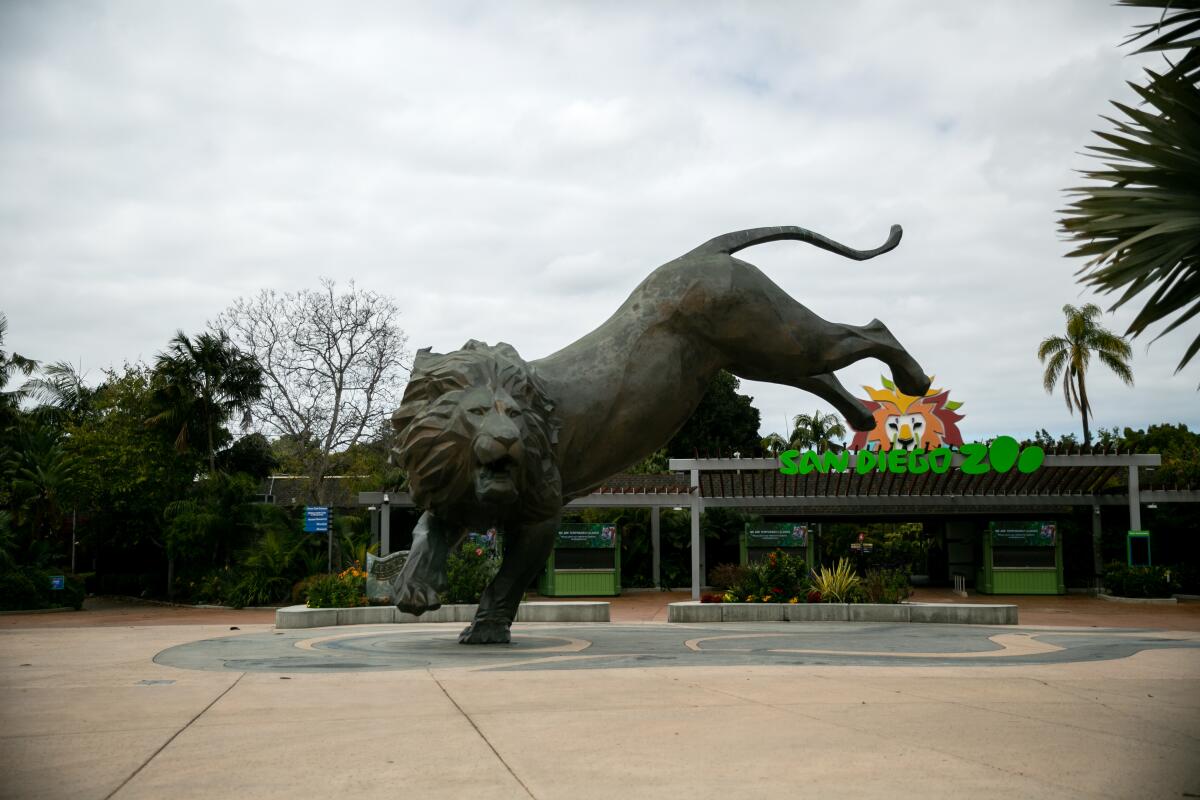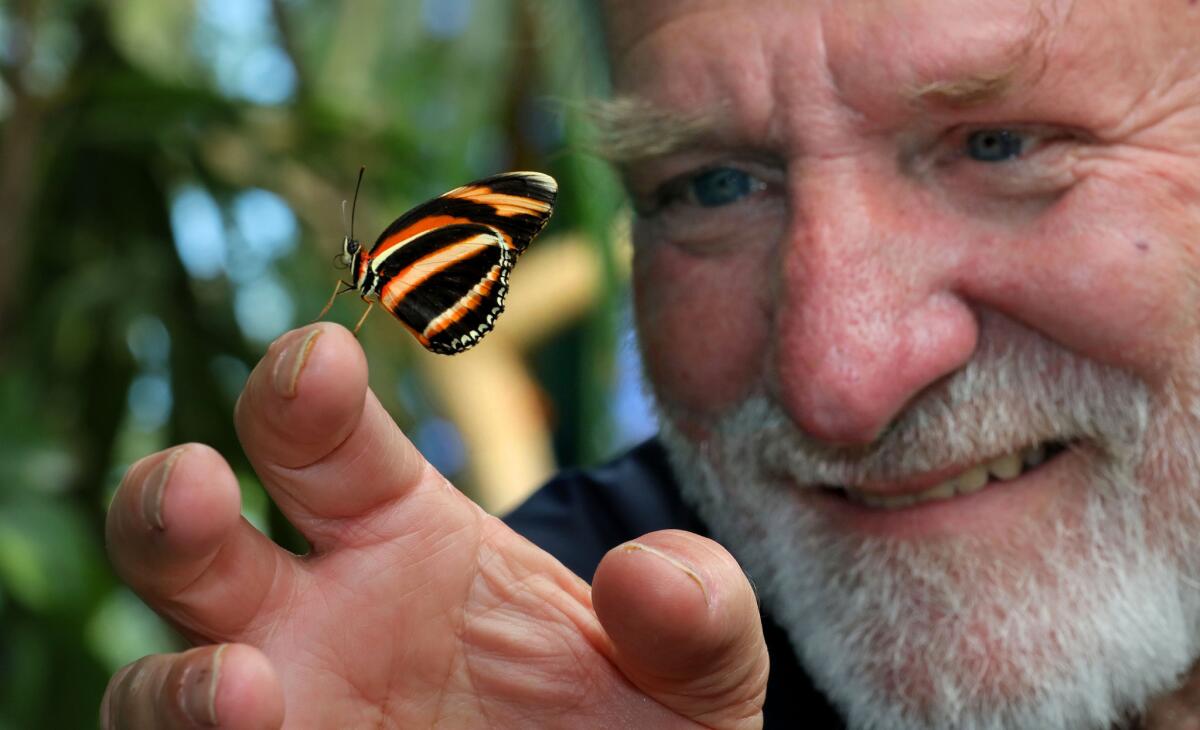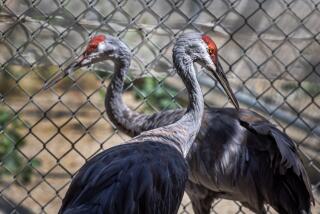A zoo without visitors: Animal care goes on as revenue dries up amid coronavirus crisis

- Share via
SAN DIEGO — Belmont Park shuts down and nobody gets to ride the Giant Dipper roller coaster. Legoland closes and tiny plastic bricks don’t get fashioned into buildings at Miniland USA.
Shutter a zoo, though, and the animals remain. They need food and care, and that costs money. You can’t furlough a flamingo. You can’t lay off a lion.
So it is that Don Sterner found himself with 4,000 exotic butterflies and no one to show them to.
Sterner is a wildlife care manager at the San Diego Zoo Safari Park, where the 43-year veteran is in charge of the birds. This time of year, he also oversees the popular Butterfly Jungle, which for two decades has temporarily taken over an aviary at the park with a riotous splash of flowering plants and fluttering wings.

Butterfly Jungle was supposed to open March 21 and run through Mother’s Day. But those plans, like countless others, were upended by the COVID-19 pandemic. The Safari Park and its sister facility, the San Diego Zoo, which together last year drew 5 million visitors, closed to the public on March 16.
By then, butterflies shipped as pupae from Central and South America were already here, some 40 species. They’d been unpacked from boxes in a climate-controlled room at the Safari Park, and pinned upside down to hang in special cases while they did their chrysalis-cracking.
They emerged and spread their colorful wings — all dressed up with somewhere to go. Public or no public.
“They’re animals, too,” Sterner said. “They get the same care any other would.”
So the show went on. The horticulture team brought thousands of plants into the aviary so the butterflies would have something to eat and somewhere to rest. They moved out birds that would have snacked on the new arrivals.
In went the zebra longwings, the giant swallowtails, the blue morphos. And on went the “butterfly cam,” a first this year, which enabled people to watch from home as the butterflies flitted about and dined on pieces of watermelon and papaya.
It’s not the same as going there, but it’s something: By Friday, people had viewed the butterflies online almost 350,000 times.
‘Never compromise care’
Together, the 100-acre zoo in Balboa Park and the 1,800-acre Safari Park near Escondido are home to more than 6,300 animals from 1,000 species, as well as more than 700,000 plants in 600 species and subspecies.
All require care, and that has continued, according to officials with San Diego Zoo Global, the umbrella organization for the two parks.
“Although the COVID-19 situation is unprecedented, the teams at the Zoo and Safari Park expend a lot of energy in developing contingency plans for unforeseen events such as this, planning for natural disasters, and never compromise care, regardless of the situation,” President and Chief Executive Paul Baribault said in a statement.
No plans, then, to do what a zoo director in Germany said his facility might be forced to consider: Slaughter some of the animals to feed to others. Verena Kaspari, who heads Tierpark Neümunster, located about an hour’s drive north of Hamburg, called that a worst-case scenario in an interview last week with the German News Agency DPA.
But things can go downhill quickly financially for zoos closed to visitors, as San Diego Zoo Global’s most recent tax filings indicate.
The nonprofit organization had total revenue of about $342 million in 2018, and expenses of about $302 million, for a net gain of $40 million. It listed net assets — cash, investments, property and equipment — of $500 million.

It spent about $231 million in 2018 on animal care and exhibition operations, according to the filings, by far the largest expense category.
It paid for that through $124 million in admissions and memberships and $130 million in auxiliary activities, which include the sales of souvenirs, food and beverages, and other merchandise at the parks, as well as parking fees at the Safari Park.
With the facilities closed, that revenue has disappeared. But its animal-care costs haven’t.
Now visitors to the parks’ websites see this message pop up first:
“Although the Zoo and Safari Park are temporarily closed, our team of dedicated specialists continue to care for countless animals and plants that depend on us each and every day. Your continued support is more critical now than ever before and will provide a vital lifeline to the wildlife in our care.”
Last week, Baribault announced a “critical needs campaign” to raise money to offset ongoing operational costs and “offer hope and reassurance, not only for wildlife at the zoo and Safari Park, but for countless endangered species around the globe.”
His organization is also backing an effort by San Diego’s congressional delegation to include zoos and aquariums in the next round of federal coronavirus aid. In a letter to House leaders last week, the delegation noted that SD Zoo Global generates $1.7 billion in economic activity annually and said the pandemic “threatens the zoo’s operations, the animals they care for, and the jobs of many of our constituents.”
The organization employs about 3,800 people, according to its 2018 tax filings. On Monday, furloughs begin for an undisclosed number of them in visitor-services jobs and other positions not related to animal or plant care.
Max, the lonely cockatoo
Those still working are doing it in staggered shifts to minimize contact with each other in the locker rooms and as they move around the zoo and Safari Park to clean habitats, prepare food, trim plants or do training and enrichment with the animals.
If social distancing guidelines have to be breached — when two people are tending to an animal, for example — “we take all the precautions we can with masks and other equipment,” Sterner, the Safari Park wildlife manager, said.
The biggest change he’s noticed since the shutdown is how quiet it is.
“It’s kind of strange, not seeing people around,” he said. “We’re looking forward to the time when everybody can come back.”
Most of the animals at the park and the zoo don’t show signs of missing the visitors, according to Greg Vicino, who is in charge of applied animal welfare at San Diego Zoo Global.
“The care we always provide at both the zoo and Safari Park is based on the different experiences the animals have every day, and how those experiences require choices, activity, rest, exploration and sensory cues,” he said in a statement. “By placing emphasis on the animals making independent choices about how to spend their time, it creates less reliance on external factors.”
Some of the ambassador animals, though, do appear to sense something is different. Max, a cockatoo at the Safari Park who is known as something of a show-off, has been quieter, according to reports Sterner has received from keepers.
He said staff members have been encouraged to spend more time interacting with him, and with Samson, a macaw, to make up for the drop in attention the birds would be receiving from visitors.
The pandemic is also causing adjustments in San Diego Zoo Global’s conservation programs. Two keepers were scheduled to fly to South Africa in June to help a local organization trying to save vultures. That trip has been pushed back at least to August.
Workers involved in the decades-long effort that brought the California condor back from the brink of extinction may have to delay a release of birds into the wild because of travel restrictions. That could make space tight at the Safari Park’s condor breeding facility.
“But we’ll figure it out,” Sterner said. “Every day, we’re finding creative ways to make this all work.”
Wilkens writes for the San Diego Union-Tribune.
More to Read
Sign up for Essential California
The most important California stories and recommendations in your inbox every morning.
You may occasionally receive promotional content from the Los Angeles Times.











